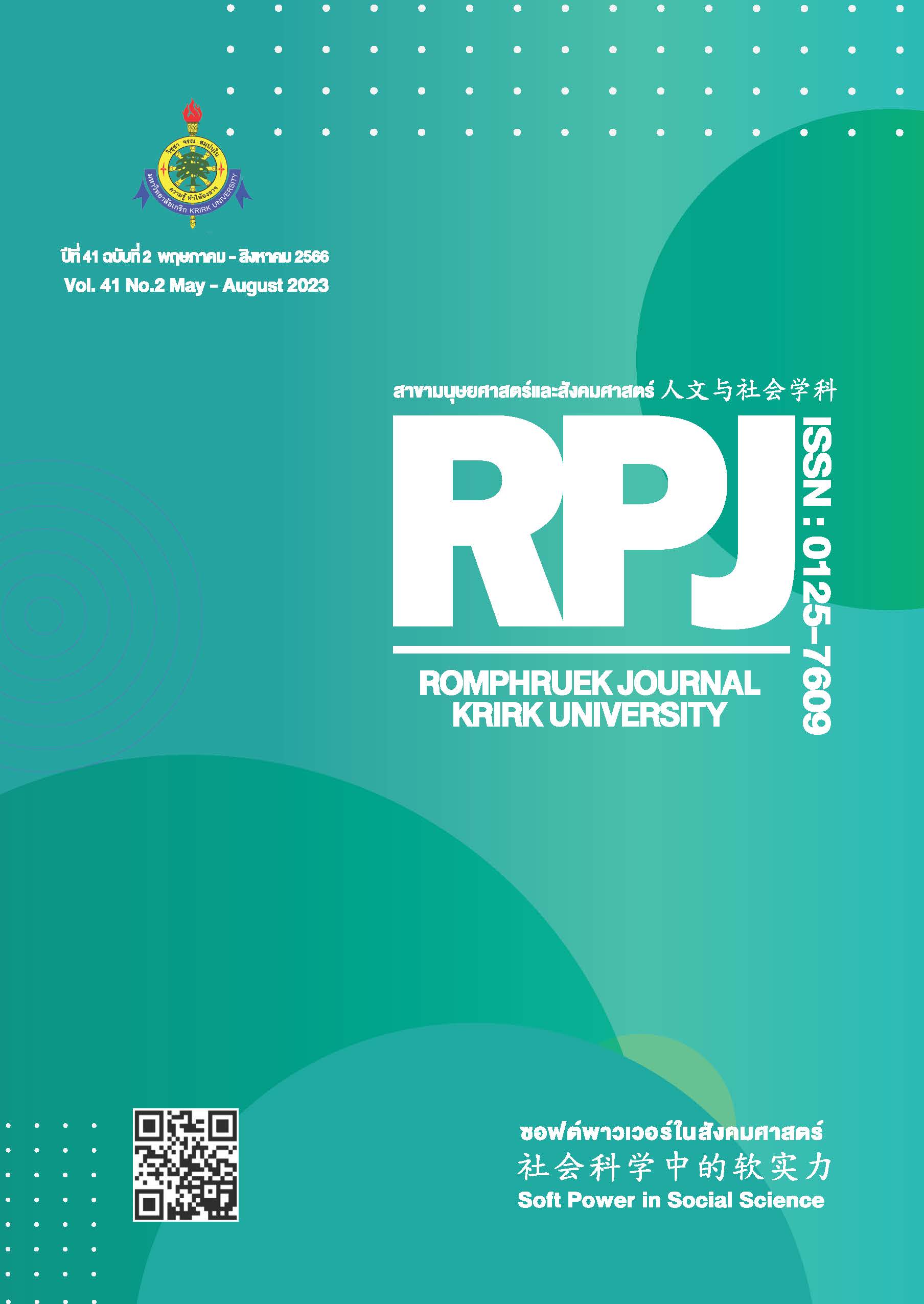Learning Leadership in the Digital Age
Main Article Content
Abstract
Learning leadership is important in the digital age because modern leaders can serve as role models in the pursuit of knowledge, creativity, bringing novelty to the development of the organization and encouraging employees to develop their work to make progress in order to gain an advantage over competitors. They can develop the employees’ potential to bring knowledge as well as the ability to work together to achieve the goals with the following key elements: 1) becoming a learning person 2) building a learning network 3) promoting team learning; 4) digital transformation; and 5) human resource development.
Article Details

This work is licensed under a Creative Commons Attribution-NonCommercial-NoDerivatives 4.0 International License.
Every article published in the Romphruek Journal of the Humanities and Social Sciences is the opinion and point of view of the authors. Thery're not the viewpoint of Krirk University or the editored department. Any part or all of the articles for pablication must be clearly cited.
References
ณัฐวุฒิ พงศ์สิริ. (2560). การเปลี่ยนผ่านสู่ยุคเศรษฐกิจดิจิทัล. (6 ธันวาคม 2564), สืบค้นจากhttps://www.dst.co.th/.
ประยงค์ รณรงค์. (2559). ภาวะผู้นำการเรียนรู้. กรุงเทพฯ :สถาบันส่งเสริมการจัดการความรู้เพื่อสังคม (สคส.) ในสังกัดสำนักงานกองทุนสนับสนุนการวิจัย (สกว.).
รังสรรค์ ประเสริฐศรี. (2551). ภาวะผู้นำ. กรุงเทพมหานคร : ธนธัชการพิมพ์.
สมชาย เทพแสง. (2557). ภาวะผู้นำแห่งการเรียนรู้ : รูปแบบของภาวะผู้นำสมัยใหม่.วารสารบริหารการศึกษามหาวิทยาลัยศรีนครินทรวิโรฒ, 6(11), 83-95.
สมชาย เทพแสง. (2559). กลยุทธ์ภาวะผู้นำร่วมสมัย. กรุงเทพฯ: ดอนบอสโก.
สำนักงานคณะกรรมการการศึกษาแห่งชาติ. (2558). ยุทธศาสตร์เพื่อพัฒนาขีดความสามารถในการแข่งขันของประเทศ.กรุงเทพฯ: สำนักพิมพ์พิมพ์ดี.
Antonacopoulou, E. P., & Bento, R. F. (2003). Methods of ‘learning leadership’: Taught and experiential. London : Routledge.
Argyris, Chris. (1999). On Organizational Learning. London: Blackwell Publishing.
Brown,Lillas M. & Posner, Barry Z. (2001). Exploring the Relationship Between Learning and Leadership. Leadership & Organization Development Journal, 22(6), 274 – 280.
Chandler,Alfred D. (2010). Strategy and Structure Cambridge, Mass.; The M.I.T.Pess.
Charles C. Snow . (2017). Designing the digital organization. Journal of Organization Design, 6(1), 1-13.
Daft, Richard l. (1999). Leadership Theory and Practice. Orlando : The Dryden Press.
David ,Fred R. (2008). Strategic Management. New Jersey: Prentice – Hall.
Deborah ,King. (2002).The Changing Shape of Leadership. Educational Leadership, 59(8), 61-63.
Dessler, Gary. (2014). Human Resource Management. New Jersey : Prentice Hall.
Desmet, D., Duncan, E., Scanlan, J. & Singer, M. (2015). Six building blocks for creating a high-performing digital enterprise. McKinsey Digital, 3(4),1-8.
Garvin, D. A. (1993). Learning Organization. Boston : Harvard University Press.
Gilley, Jerry and Ann Maycunich. (2000). Beyond the Learning Organization. New York:Cambridge.
Gilley and Eggland ,S.A. (2002). Principles of Human Resource Development. Cambridge MA: Persus Publishing.
Grieves, J. (2003). Strategic Human Resource Development. London: Sage.
Hayes, Nicky. (1997). Successful Team Management. London : Thomson.
Hess, T. (2016). Options for formulating a digital transformation strategy. MIS Quarterly Executive, 15(2), 123-139.
Hong , Bui & Yehud, Baruch. (2010). Creating Learning Organizations in Higher Education : Applying a Systems Perspective, The Learning Organization. 17(2), 55-65.
Jichang Zhang. (2021). How Does Digital Transformation Improve Organizational Resilience. Sustainability Journal, 13(20), 22-30.
Kaiser, S. M. (2000). Mapping the Learning Organization : Exploring A Model of Organizational Learning. Dissertation Abstract International, 2(4), 725 - A.
Kane, G. C. (2015). Strategy, not technology, drives digital transformation. London: Deloitte University.
KontiC, L. & Vidicki, D. (2018). Strategy for digital organization: Testing a measurement tool for digital transformation. Strategic Management, 23(1), 29-35.
Kouzes, J. M and Posner, B. Z. (2016). Learning leadership: The five fundamentals of becoming an exemplary leader. New York : John Wiley & Sons.
Kurt Sandkuhl and Holger Lehmann. (2017). Digital Transformation in Higher Education – The Role of Enterprise Architectures and Portals, in Lecture Notes in Informatics (LNI). Gesellschaft für Informatik, 49(2), 49-60.
Law , Sue. (2000). Educational Leadership and Learning. Bucking &Philadelphia : Open University Press.
Neuman, Marry & Simmons,Warren. (2013). Leadership For Student Learning. Phi Delta Kappan Journal, 3(2), 111-116.
Paletta, Angelo. (2017). Leadership for learning: The relationships between school context, principal leadership and mediating variables. International Journal of Educational Management, 31(2), 98-117.
Paradise, Ruth & De Haan, Mariëtte. (2009). Responsibility and Reciprocity: Social Organization of Mazahua Learning Practices. Anthropology & Education Quarterly, 40(2), 187–204.
Rayner, S. (2009). Educational diversity and learning leadership: A proposition, some principles and a model of inclusive leadership. Educational Review, 61(4), 433-447.
Salas, Eduardo, Nancy J. Cooke, & Michael, Rosen. (2008). On Teams, Teamwork, as well as Team Performance: Discoveries and Developments. Human Factors. The Journal of the Human Factors and Ergonomics Society, 50(3), 540–547.
Senge, P.M. (2006). The Fifth Discipline: The Art and Practice of the Learning Organization. New York: Doubleday/Currency.
Singh, A. & Hess, T. (2017). How chief digital officers promote the digital transformation of their companies. MIS Quarterly Executive, 16(2), 1-17.
Steven Appelbaum,H. & Lars, Goransson. (1997). Transformational and adaptive learning organization: a framework for research and application. The Learning Organization, 4(3),115-128.
Wang, C.L. & Ahmed, P.K. (2003). Organizational learning: a critical review. The learning organization, 10(1), 8-17.
William, Richard. (2005). Managing Employee Performance. London: Thomson press.


